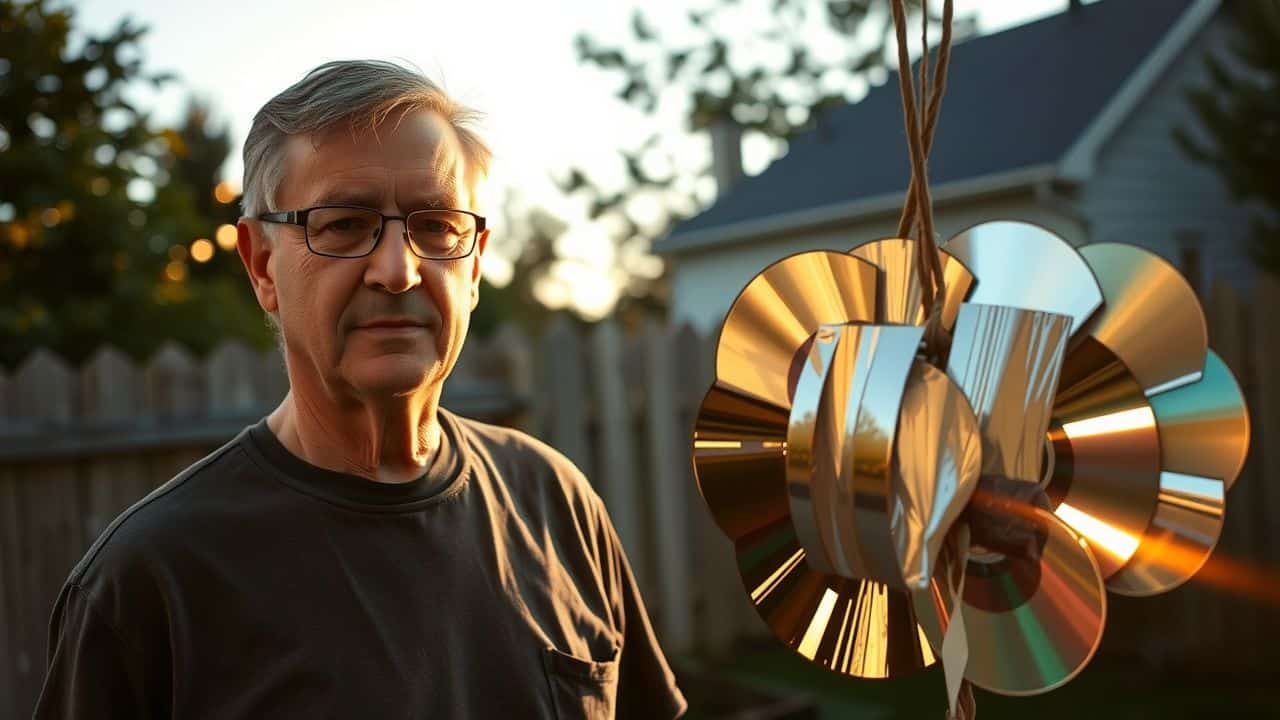Birds can be a real pain when they invade your space. Did you know that common nuisance birds include pigeons, seagulls, and starlings? This article will show you how to keep birds away with seven tricks that really work.
Ready to take back control of your yard?
Key Takeaways
Use visual deterrents like fake owls, reflective tapes, and scare balloons to trick birds into thinking predators are nearby.
Set up ultrasonic devices that emit high-frequency sounds annoying to birds but not humans. Place them strategically and vary sound patterns for best results.
Install physical barriers such as bird netting, anti-bird spikes, and bird wire to prevent birds from landing. These can cut pigeon numbers by nearly 70%.
Plant bird-repelling vegetation like marigolds, lavender, and peppermint. These natural options smell bad to birds and keep them away.
Maintain deterrents through regular inspections, cleaning reflective items, refreshing sprays, and adjusting strategies seasonally to ensure long-term effectiveness.
Table of Contents
Identifying Common Nuisance Birds
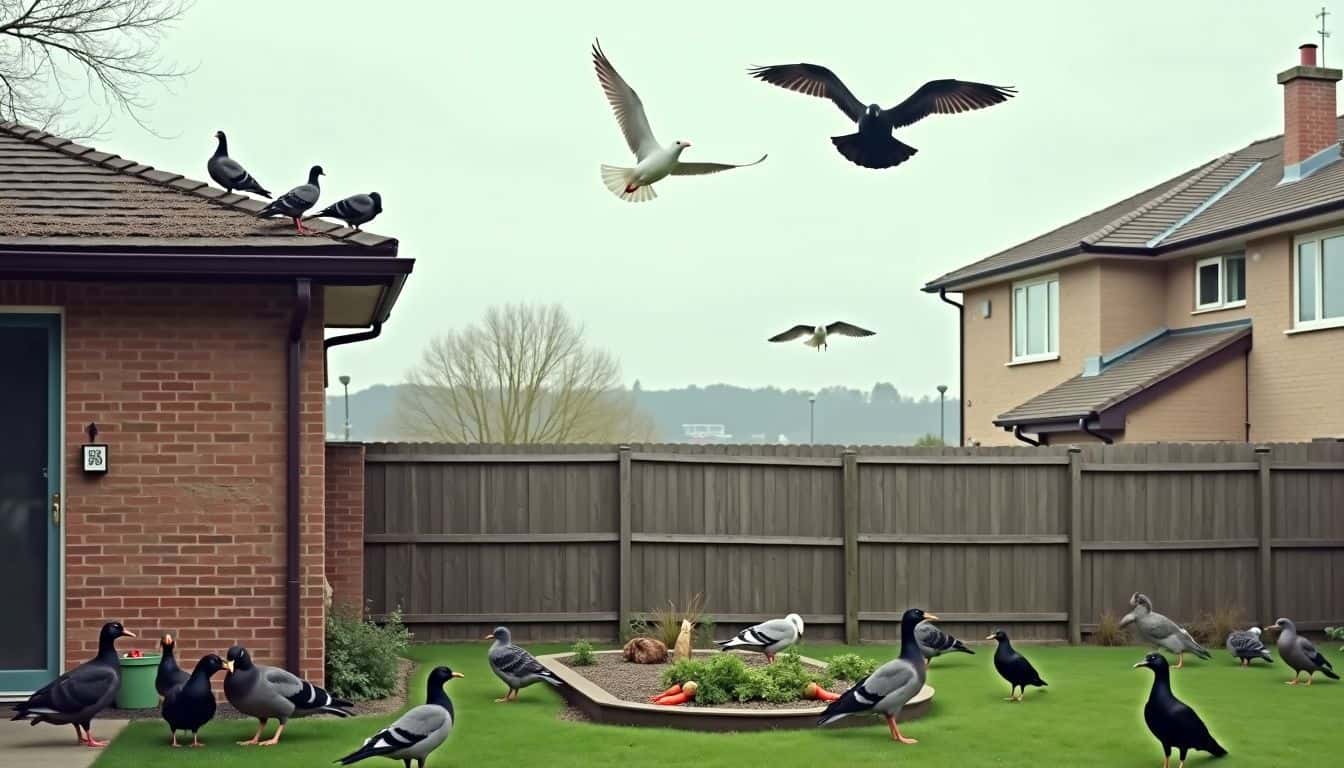
Let’s talk about the feathered troublemakers in our yards. Pigeons, seagulls, starlings, sparrows, crows, geese, and grackles top the list of pest birds. These winged visitors can be a real headache! Pigeons are messy roommates, leaving droppings everywhere and building nests in the worst spots.
Seagulls? They’re like tiny wrecking balls with wings, potentially damaging your property. And don’t get me started on starlings and sparrows – they’re small but mighty pests.
I once had a run-in with a flock of crows in my garden. They were smart, noisy, and loved to snack on my veggies. Geese can be bullies too, taking over lawns and leaving “presents” behind.
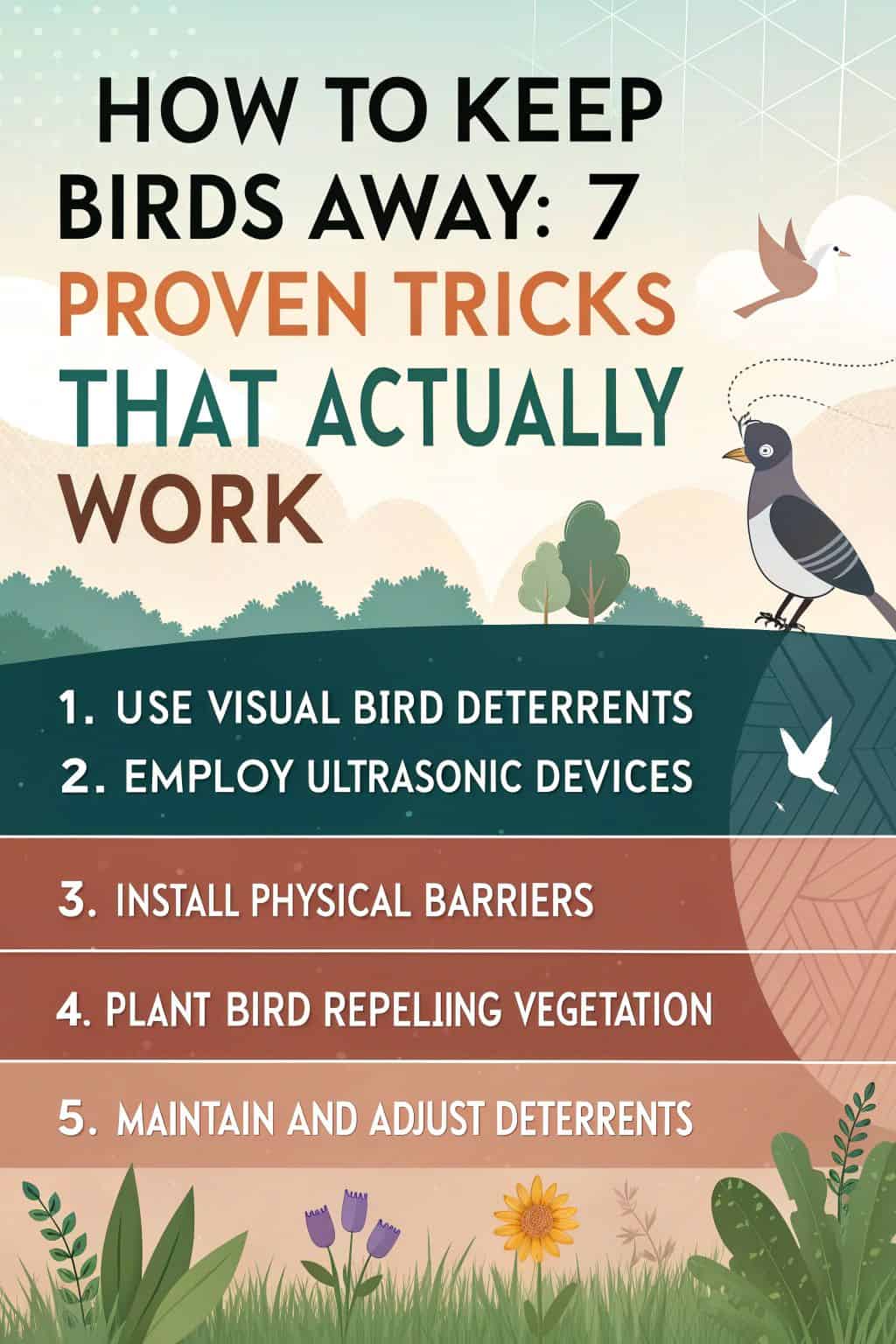
Grackles? They’re the party crashers of the bird world, showing up uninvited and making a racket. Knowing which birds are causing trouble is step one in bird control. It helps you pick the right tricks to keep them away.
So, next time you hear a flutter or see a feather, take a closer look – you might just spot one of these usual suspects!
Implementing Effective Bird Deterrent Strategies

Birds can be pesky visitors. Let’s explore some tricks to keep them at bay.
These methods work like a charm and won’t break the bank. From visual scares to sound devices, we’ve got you covered.
Use Visual Deterrents Like Scare Owls and Reflective Tapes
 Visual deterrents offer a simple yet effective way to keep birds at bay. These tricks fool birds into thinking predators are nearby, making your space less inviting.
Visual deterrents offer a simple yet effective way to keep birds at bay. These tricks fool birds into thinking predators are nearby, making your space less inviting.
- Scare Owls: Plastic owl figures trick birds into thinking a real predator is around. Place them on roofs, fences, or in gardens to ward off pesky birds.
- Reflective Tapes: Shiny strips create flashes of light that confuse and scare birds. Hang them near problem areas for quick results.
- Scare Eye Balloons: These $10.55 balloons have large “eyes” that make birds think they’re being watched. Hang them from trees or gutters.
- Holographic Guardian Owl: At $18, this fake owl moves and shines in the light. It’s a step up from static owl figures.
- Flash Tape: This $4.85 holographic tape sparkles and moves in the wind. It’s cheap and easy to use in many spots.
- Bird Scare Stakes: Stick these in your garden to keep birds away from your veggies. They often have reflective parts or predator shapes.
- Octopus Bird Deterrent: This $10.80 device has moving arms that spook birds. It’s great for patios or small yards.
Now, let’s look at some noise-based tricks to keep those feathered pests away.
Set Up Auditory Deterrents Such as Ultrasonic Devices
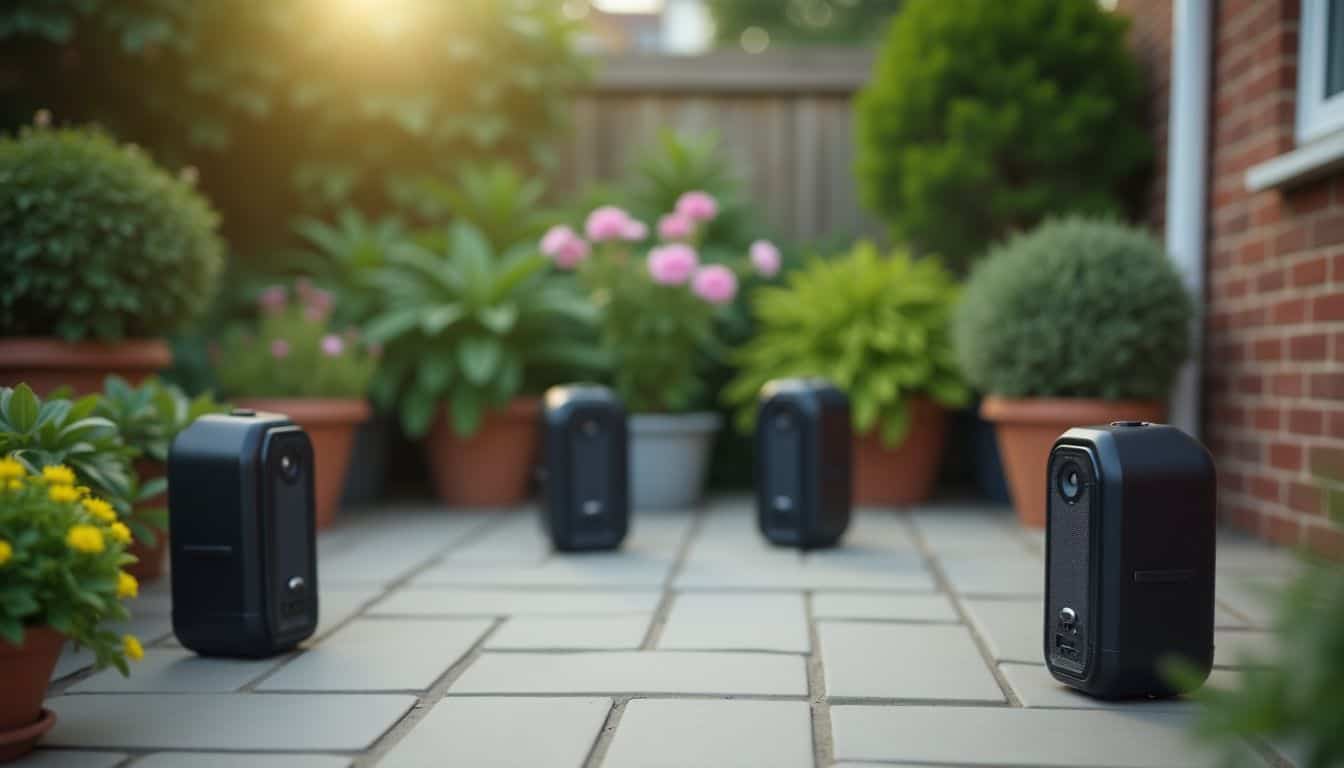
Auditory deterrents offer a smart way to keep pesky birds at bay. Let’s explore how ultrasonic devices can help you reclaim your outdoor space.
- Choose the right device: Pick an ultrasonic bird repeller that emits high-frequency sounds. These sounds bug birds but don’t bother humans.
- Place strategically: Set up your device where birds often hang out. Think roofs, gardens, or patios.
- Vary the sounds: Many devices let you change sound patterns. This stops birds from getting used to one noise.
- Cover more ground: For big areas, use multiple devices. This creates a wider “no-fly zone” for birds.
- Check power source: Some units are battery-powered, others plug in. Pick what works best for your setup.
- Adjust as needed: Start with lower settings and dial up if birds still come around. Finding the sweet spot takes a bit of trial and error.
- Pair with other methods: Ultrasonic devices work great with visual scares like shiny objects or fake owls. Double trouble for those feathered pests!
- Be patient: It might take a few days for birds to get the message. Stick with it, and you’ll see results.
Install Physical Barriers Like Bird Netting and Anti-Bird Spikes
 Physical barriers are a solid way to keep birds at bay. Let’s explore some effective options that’ll help you reclaim your space:
Physical barriers are a solid way to keep birds at bay. Let’s explore some effective options that’ll help you reclaim your space:
- Bird netting: This flexible mesh creates a no-fly zone. It’s perfect for gardens, balconies, and roofs. An anti-bird netting service can install it properly to avoid bird entanglement.
- Anti-bird spikes: These pointy deterrents stop birds from landing. They cut pigeon numbers by nearly 70%. Place them on ledges, windowsills, and roof edges.
- Bird wire: This taut wire system makes perching uncomfortable. It’s less visible than spikes but just as effective.
- Electric track systems: These give birds a mild shock when they land. Don’t worry, it won’t harm them – just teach them to stay away.
- Optical gel: This sticky substance looks like fire to birds. A 24-pack cost about $105. It’s great for small areas.
- Slope covers: These turn flat surfaces into slopes. Birds can’t land on them, so they move on.
- Bird slides: Similar to slope covers, these make perching impossible. They’re ideal for beams and ledges.
Now that we’ve covered physical barriers, let’s look at some natural solutions to keep those pesky birds away.
Natural and Eco-Friendly Solutions
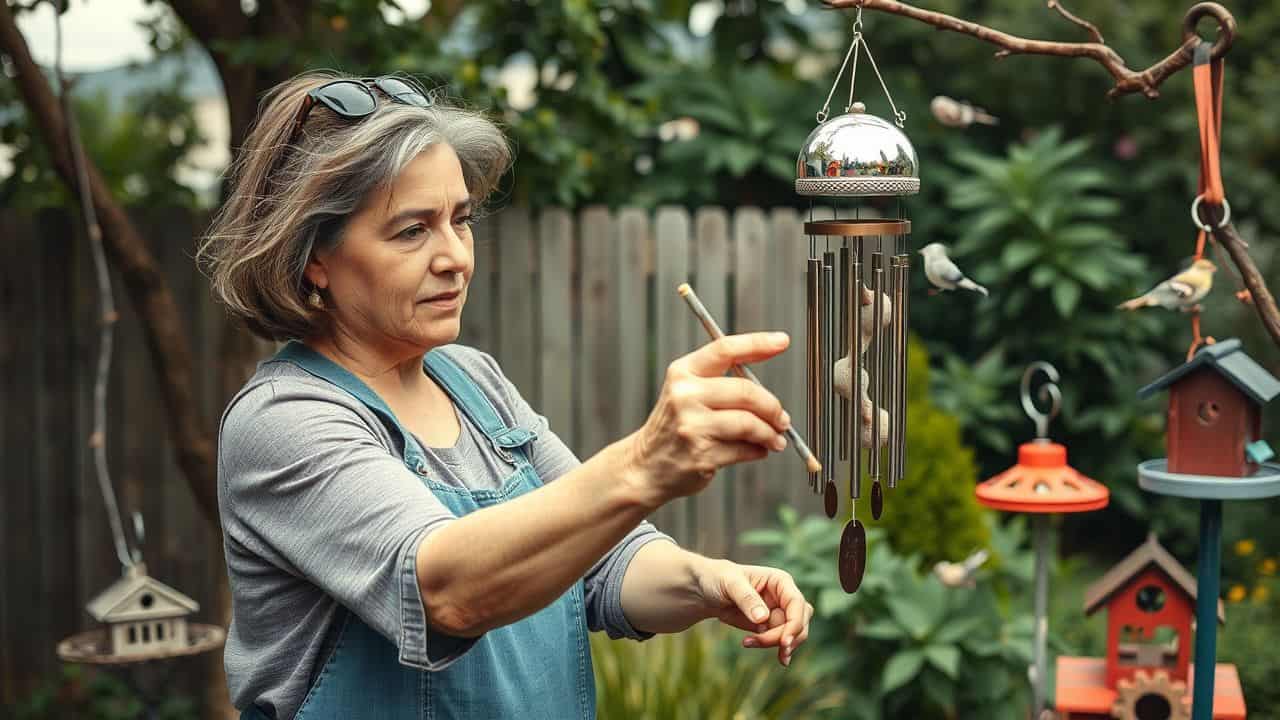
Want to keep birds away without harming them? Natural solutions are your best bet. These tricks use Mother Nature’s own playbook to shoo away pesky birds. They’re safe, smart, and – best of all – they work! Keep reading to discover how to make your yard a no-fly zone… naturally.
Plant Bird-Repelling Vegetation

Birds hate certain plants. You can use this to your advantage. Plant stuff like marigolds, lavender, or peppermint in your yard. These plants smell bad to birds. They’ll fly away fast! I’ve seen this work in my own garden.
Last year, I put lavender near my water garden. The geese stopped coming around.
You can also try planting thorny bushes. Birds don’t like to land on them. Roses or holly work great for this. Just be careful when you trim them! These plants look nice and keep birds away.
It’s a win-win for your yard. Plus, you get pretty flowers or berries as a bonus.
Nature’s own bird repellent: plants that protect and beautify.
Create Natural Predator Environments
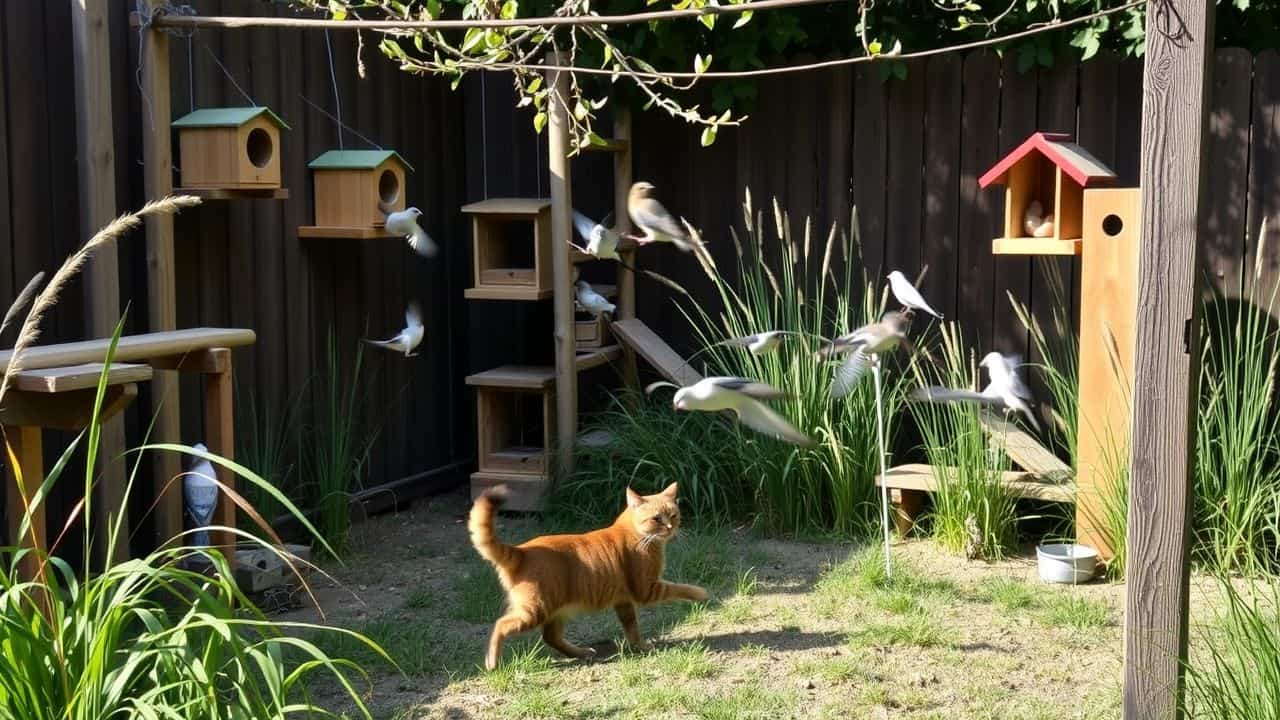
Natural predators can be your best friends in bird control. Hawks and owls are excellent at scaring off troublesome birds. I’ve seen it myself – a hawk flying by can clear a yard in seconds! You don’t have to become a falconer, though.
Just make your space welcoming for these helpful hunters. Set up perches or nesting boxes. Leave some wild areas in your yard. These spots give predators a place to rest and hunt.
Your pets can help too. Dogs and cats often chase birds away. It’s like having your own little pest control team! But keep in mind, we’re not trying to hurt birds. We just want them to find a new place to live.
Creating a predator-friendly space is a gentle way to keep birds away. It’s all about balance – letting nature do the work for you.
Use Non-Toxic Sprays and Repellents

Birds can be a pain, but we don’t have to hurt them to keep them away. Non-toxic sprays are a great fix. You can buy them or make your own at home. Mix crushed dried chili peppers, water, and vinegar for a DIY bird repellent.
It’s easy and cheap!
Avian Control offers a safe, EPA-approved option if you want to buy a spray. These sprays protect your garden without harming birds or breaking laws. They keep birds off crops and other valuable stuff.
It’s a win-win – you save your plants, and the birds stay safe. Plus, you help keep nature in balance by not killing off our feathered friends.
Maintaining a Bird-Free Environment Long-Term
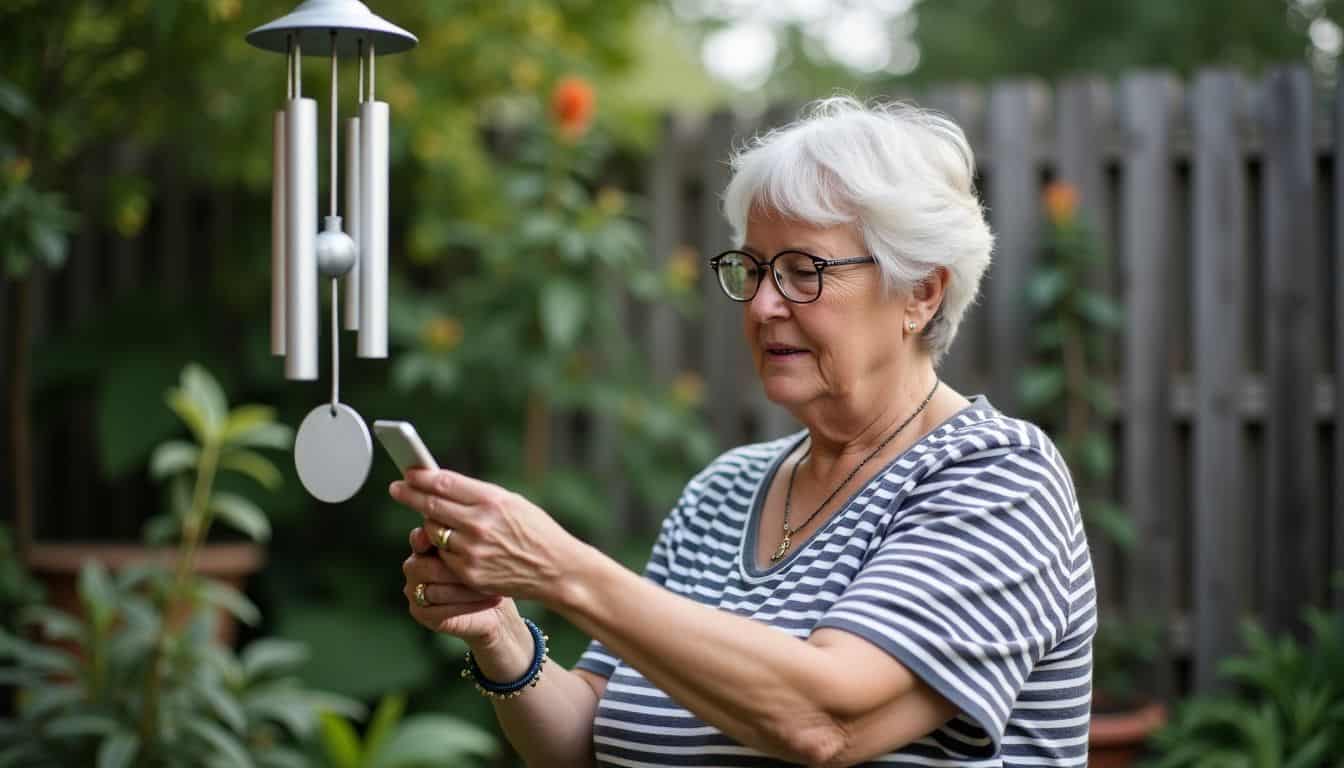
Keeping birds away isn’t a one-and-done deal. It’s an ongoing process that needs your attention. You’ll need to stay on top of things to keep those pesky birds from coming back.
Regular Inspection and Maintenance of Deterrents
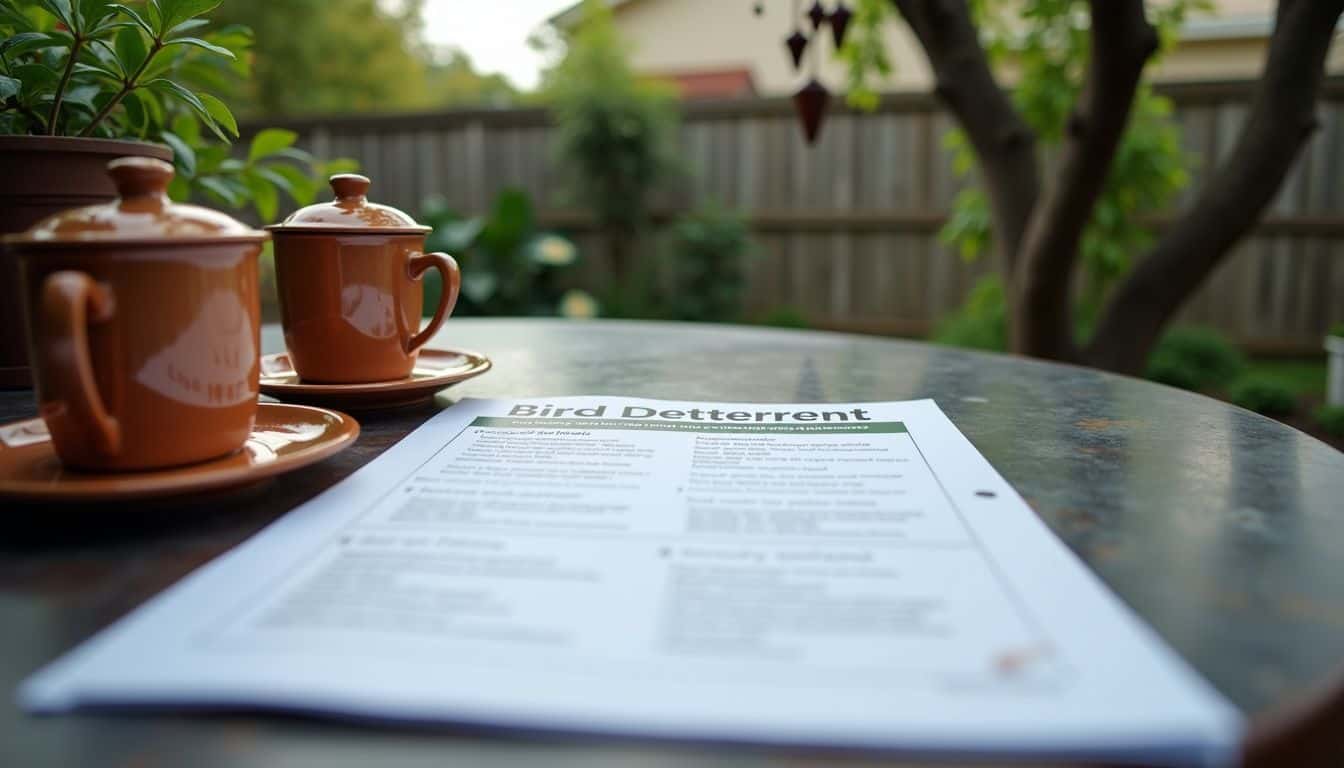
Bird deterrents need regular check-ups to stay effective. Here’s how to keep your bird-free zone in top shape:
- Weekly walk-arounds: Take a stroll around your property. Look for signs of bird activity or damage to your deterrents. This habit helps catch problems early.
- Clean those gutters: Standing water attracts birds. Empty and clean your gutters often to keep feathered visitors away.
- Shine up reflective items: Tapes or discs lose their sparkle over time. Give them a quick wipe to keep birds on their toes.
- Check for wear and tear: Wind chimes, netting, and spikes can break. Replace any worn-out parts to maintain a strong defense.
- Refresh natural sprays: Non-toxic repellents wash away in rain. Reapply these eco-friendly options as needed.
- Trim bird-repelling plants: Keep your bird-unfriendly vegetation healthy. Prune and care for these plants to boost their effectiveness.
- Update seasonal strategies: Birds’ habits change with the seasons. Adjust your methods to match their current behavior.
- Test sound devices: Make sure ultrasonic gadgets still work. Replace batteries or fix any technical issues promptly.
- Tighten loose fittings: Secure any wobbly deterrents. Loose items might fall and create gaps in your defense.
- Document your efforts: Keep a log of your maintenance. This helps track what works best for your specific bird problems.
Modifying Your Property’s Landscape

Updating your yard can discourage birds. Add trees and shrubs that birds avoid. Peppermint, lavender, and marigolds work well. These plants have strong scents for birds. They’ll keep their distance.
Also, take away things birds enjoy. Remove bird baths and feeders. Cover standing water. Birds need water to survive, so they’ll look elsewhere.
A bird-free garden starts with smart planting choices.
Consider your garden layout too. Use gravel or rocks instead of mulch. Birds don’t like walking on these surfaces. Add fences or walls to block flight paths. This makes it tougher for birds to enter.
Keep in mind, a clean yard is essential. Clean up fallen fruit and seeds. Keep trash cans covered. With fewer food sources around, birds will find other places to visit.
Implementing Seasonal Prevention Strategies
Birds change their habits with the seasons. Smart bird control means staying one step ahead of these feathered friends. Here’s how to keep your property bird-free year-round:
- Spring: Nesting season calls for extra vigilance. Set up barriers around potential nesting spots. Use reflective tape or pinwheels to scare off early arrivals.
- Summer: Hot weather brings thirsty birds. Remove standing water sources. Cover birdbaths and fountains. Plant herbs like mint or rosemary – birds hate their strong scent.
- Fall: Migration time means more birds passing through. Hang wind chimes or bells to create noise. Put up fake predators like owls or hawks to spook flocks.
- Winter: Food becomes scarce, making your yard tempting. Clear away fallen fruit and berries. Use netting to protect vegetable gardens. Seal off any warm spots where birds might roost.
- Year-round: Keep an eye on bird forecasts. They’ll tell you when flocks are on the move. Adjust your tricks based on what types of birds are common each season.
- Rotate your methods: Birds are smart. They’ll get used to the same old tricks. Switch up your deterrents every few weeks to keep them guessing.
- Team up with neighbors: Birds don’t care about property lines. Work together to create a larger bird-free zone. Share tips and tools to boost everyone’s efforts.
People Also Ask
Can falconry keep birds away from my garden?
Yep, falconry’s a neat trick! Falcons scare off pesky birds. Their sharp eyes and swift moves make other birds think twice about hanging around. It’s like having a flying guard dog for your veggies!
How do birds’ sense of sight affect their roosting habits?
Birds have eagle eyes, no joke! Their keen sight helps them spot safe spots to roost. If they see something scary, they’ll fly the coop. That’s why visual deterrents can be a game-changer in keeping them at bay.
Do birds play a role in pollination?
You bet! Birds are nature’s little helpers. They flit from flower to flower, spreading pollen like tiny flying gardeners. But when they overstay their welcome, it’s time to show them the door.
How can changing a bird’s habitat affect its perception of an area?
Birds are creatures of habit. Shake things up in their hangout spot, and they’ll get confused. It’s like rearranging your living room – suddenly, it doesn’t feel like home anymore. This trick can make them pack their bags and find a new place to crash.
References
https://aviancontrolinc.com/get-rid-of-birds/
https://www.homeimprovementandrepairs.com/post/keep-birds-away-with-these-7-tips (2023-03-13)
https://www.ncbi.nlm.nih.gov/pmc/articles/PMC11416946/
https://www.ncbi.nlm.nih.gov/pmc/articles/PMC5081983/ (2016-10-27)
https://www.worldbirdstrike.com/images/Resources/PDF_Articles/birdscaring_EFFECTIVENESS.pdf
https://www.mdpi.com/2077-0472/13/4/774
https://digitalcommons.unl.edu/cgi/viewcontent.cgi?article=3754&context=icwdm_usdanwrc
https://www.callnorthwest.com/2022/05/9-easy-ways-to-keep-birds-away/ (2022-05-19)
https://aviancontrolinc.com/how-to-keep-birds-away/ (2024-01-26)
https://www.birds.cornell.edu/home/seven-simple-actions-to-help-birds/
